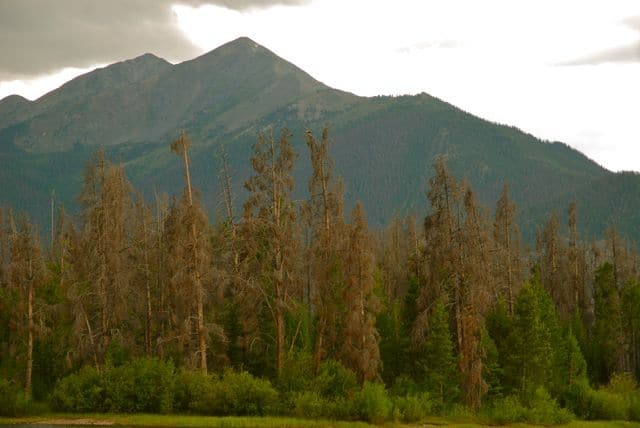Instead of taking on the proposed forest planning regulations in one fell swoop, I’d like to use our blog to analyze it in sections, with a lot of debate and discussion along the way. There are things in the proposed regulations that I really like. And I’m planning on writing about those soon. But I’d like to start with some connected questions that our readers might be able to help answer.
1. Do the regulations give too much discretion to National Forest Supervisors? The USFS, like most bureaucracies, will go down swinging in order to protect their administrative discretion. It’s part of the agency’s (and Sharon’s) DNA. And there is a considerable amount of discretion provided in the proposed regulations, though nothing close to 2005 or 2008 versions. It will be up to the discretion of each National Forest to determine what the specifics look like in every place (and how standards, guidelines, suitability, monitoring, and other plan components are used). Discretion cuts both ways and the regulations could be used to draft very different forest plans in the future. This is not necessarily a big change from the past.
2. Do the regulations ask planners to do too many things? Does the 2011 rule ask more things of the agency than does the 1982 or 2000 versions? I read Andy Stahl’s insightful comments before I finished reading the regulations, so I was influenced by his argument that the proposed regs are a form of “ecological rationality.”
So I made a note of how many times the regulations ask planners to “consider” or “take into account” X, Y, Z. This is pretty standard in environmental law and planning, but I’m curious if these regulations take it up a notch?
Instead of mandating that the agency shall do this or that, the regulations require all sorts of important things to be considered or taken into account. I can’t complain because I asked the agency as part of its Science Panel to consider various things when planning, so I’m guilty too (like most groups whom asked the agency to consider something better in the future).
Before skimming the list below, consider a few questions: Are these required considerations a good thing? Will they impact agency decision making? Is the agency capable of doing all this? How do these required considerations simplify planning? Are the considerations nothing new, maybe already required or done as part of NEPA analysis?
Here are some examples, with Fed. Reg. page numbers provided:
The planning process would take into account other forms of knowledge, such as local information, national perspectives, and native knowledge. 8481.
In doing so, responsible officials would take into account the various stressors or impacts that could affect the presence of ecological resources and their functions on the unit.
This section of the proposed rule addresses the role of science in planning and would require that the responsible official take into account the best available scientific information. 8485.
Additionally, the proposed rule would require the responsible official to use collaborative processes when possible, to take into account the various roles and responsibilities of participants and the responsibilities of the Forest Service itself, and to create a process that is open and accessible. 8486.
In designing plan components to maintain or restore ecosystems and watersheds, the proposed rule would require the responsible official to take into account the physical (including air quality) and biological integration of the terrestrial and aquatic ecosystems within a landscape. 8490
Agency proposes that the planning rule require responsible officials to take into account cultural conditions when developing plan components for social and economic sustainability. 8492.
In developing these plan components, the responsible official would be required to take into account through the collaborative planning process and the results of the assessment the social, cultural, and economic conditions relevant to the area influenced by the plan; the distinctive roles and contributions of the unit within the broader landscape; sustainable recreational opportunities and uses; multiple uses, including ecosystem services, that contribute to local, regional, and national economies in a sustainable manner; and cultural and historic resources and uses.
Instead of adding a new aspect to sustainability, the Agency proposes that the planning rule require responsible officials to take into account cultural conditions when developing plan components for social and economic sustainability. 8492
The proposed rule would require responsible officials to consider opportunities to coordinate with neighboring landowners to link open spaces and take into account joint management objectives where feasible and appropriate. 8495
The responsible official would also be required to consider the landscape-scale context for management as identified in the assessment and the land ownership and access patterns relative to the plan area. These requirements reflect the ‘‘all lands’’ approach the Agency is taking to resource management. 8495
Paragraphs (a)(8) and (a)(9) would require that the responsible official take into account reasonably foreseeable risks to ecological, social, and economic sustainability and the potential impacts of climate and other system drivers, stressors, and disturbance regimes, such as wildland fire, invasive species, and human-induced stressors, on the unit’s resources. 8495
Plan components must also take into account cultural and historic resources and uses. 8513.
Section 219.4(a) requires that when developing opportunities for public participation, the responsible official shall take into account the discrete and diverse roles, jurisdictions, responsibilities, and skills of interested and affected parties as well as the accessibility of the process, opportunities, and information. 8513
When developing opportunities for public participation, the responsible official shall take into account the discrete and diverse roles, jurisdictions, responsibilities, and skills of interested and affected parties; the accessibility of the process, opportunities, and information; and the cost, time, and available staffing. 8515.
(a) Integrated resource management. When developing plan components for integrated resource management, to the extent relevant to the plan area and the public participation process and the requirements of §§ 219.7, 219.8, 219.9, and 219.11, the responsible official shall consider:
(1) Aesthetic values, air quality, cultural and heritage resources, ecosystem services, fish and wildlife species, forage, geologic features, grazing and rangelands, habitat and habitat connectivity, recreational values and settings, riparian areas, scenery, soil, surface and subsurface water quality, timber, trails, vegetation, viewsheds, wilderness, and other relevant resources; (2) Renewable and nonrenewable energy and mineral resources; (3) Sustainable management of infrastructure, such as recreational facilities and transportation and utility corridors; (4) Opportunities to coordinate with neighboring landowners to link open spaces and take into account joint management objectives where feasible and appropriate; (5) Habitat conditions, subject to the requirements of § 219.9, for wildlife, fish, and plants commonly enjoyed and used by the public, such as species that are hunted, fished, trapped, gathered, observed, or needed for subsistence; (6) The landscape-scale context for management as identified in the assessment; (7) Land ownership and access patterns relative to the plan area; (8) Reasonably foreseeable risks to ecological, social, and economic sustainability; and (9) Potential impacts of climate and other system drivers, stressors and disturbance regimes, such as wildland fire, invasive species, and human induced stressors, on the unit’s resources (§ 219.8).
(5) To the extent practicable, appropriate, and relevant to the monitoring questions in the program, unit monitoring programs and broaderscale strategies must be designed to take into account: (i) Existing national and regional inventory, monitoring, and research programs of the Agency, including from the NFS, State and Private Forestry, and Research and Development, and of other governmental and non-governmental parties; (ii) Opportunities to design and carry out multi-party monitoring with other Forest Service units, Federal, State or local government agencies, scientists, partners, and members of the public; and (iii) Opportunities to design and carry out monitoring with federally recognized Indian Tribes and Alaska Native Corporations. 8521.
Etc.




